Doves are among the most graceful and widely recognized birds in the world, known for their gentle cooing, peaceful nature, and symbolic meanings across cultures. With their soft plumage and elegant flight, they are a favorite among birdwatchers and nature lovers alike. But did you know there are many types of doves found in a wide range of habitats, from urban parks to dense tropical forests?
In this comprehensive guide, we’ll explore 45 types of doves, each with its own unique appearance, behavior, and habitat preferences. If you’re trying to identify a dove in your backyard or learning more about exotic species from around the globe, this guide offers detailed descriptions and vivid images to help you recognize each one with ease.
From the familiar Mourning Dove to the rare Nicobar Pigeon, the types of doves featured in this list span nearly every continent. With their wide variety of colors, calls, and ecological roles, these birds are far more diverse than most people realize—making them a fascinating group worth discovering.
Common and Popular Dove Species
Mourning Dove (Zenaida macroura)
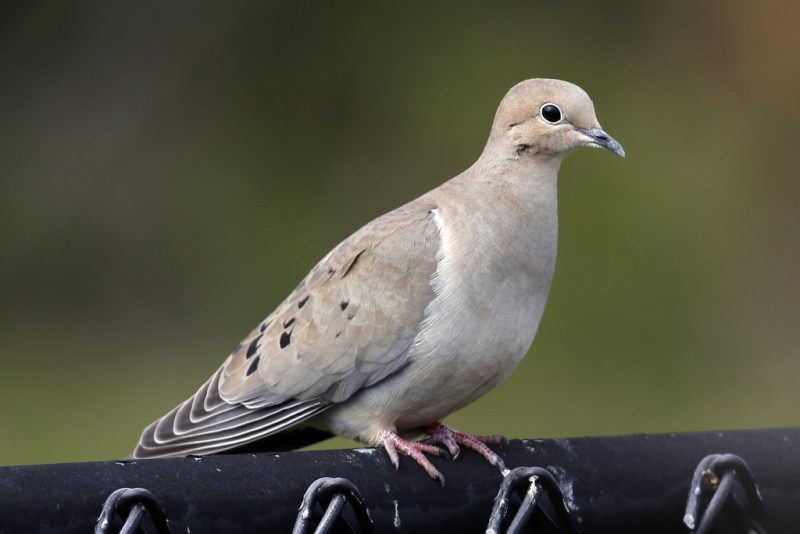
The Mourning Dove is one of the most widespread and familiar doves in North America. It has a slender, streamlined body with a small head, long pointed tail, and soft brownish-tan plumage. Black spots on the wings and a delicate blue ring around the eye add to its subtle beauty. Its soft, sorrowful cooing call gives the species its name.
This dove is commonly found in open habitats including fields, roadsides, parks, and suburban areas. It often perches on telephone wires and forages on the ground for seeds, which make up the majority of its diet. Mourning Doves are known for their strong, fast flight and can reach speeds of up to 55 mph.
They are monogamous and nest frequently during the breeding season, sometimes raising up to six broods in a year. A fun fact: the whistling sound you hear when a Mourning Dove takes off is produced by its wings, not its voice.
Eurasian Collared-Dove (Streptopelia decaocto)
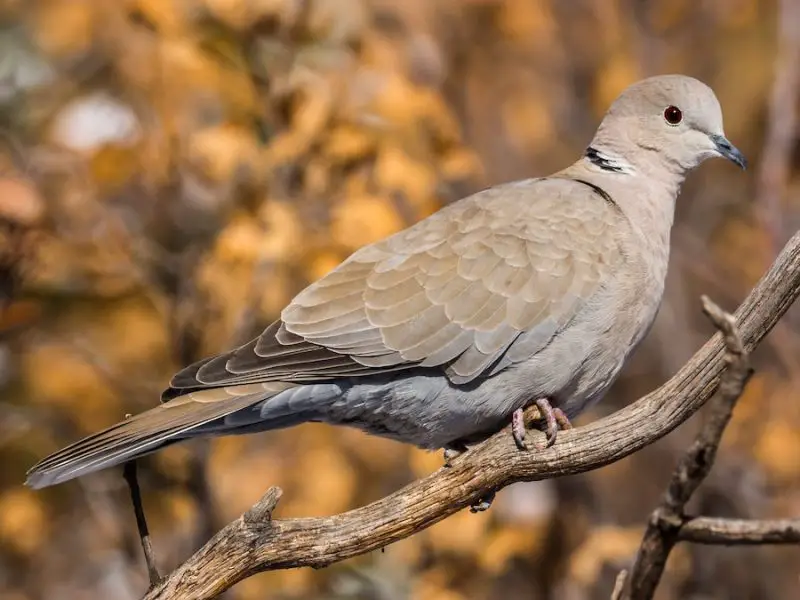
The Eurasian Collared-Dove is a pale, medium-sized dove recognized by the distinct black crescent or “collar” on the nape of its neck. It has a light gray to sandy body with broad, squared-off wings and a long tail. Its cooing is a simple three-part “coo-COO-coo,” often repeated persistently.
Originally from Europe and Asia, it was introduced to the Bahamas in the 1970s and quickly spread across North America. Today, it is commonly found in cities, small towns, farms, and residential areas where food sources like bird feeders are abundant.
This species is bold and adaptable, often seen perching on rooftops and electrical wires. A fun fact: its rapid expansion across the United States is one of the fastest documented avian invasions in history.
White-winged Dove (Zenaida asiatica)

The White-winged Dove is a large, stout dove distinguished by broad white wing patches visible in flight, and a bluish ring around its eyes. Its body is generally grayish-brown with a slightly pinkish hue on the chest. When perched, the white on its wings appears as narrow edges.
It is native to the southwestern United States, Mexico, Central America, and parts of the Caribbean. It favors desert scrub, woodlands, and urban areas, especially near saguaro cacti and agave, which it uses for nesting in the wild.
White-winged Doves are migratory and known for their high-pitched “who-cooks-for-you” call. A fun fact: in the Sonoran Desert, they time their nesting to coincide with the blooming of saguaro cactus flowers, whose nectar and fruit they feed on.
Common Ground Dove (Columbina passerina)
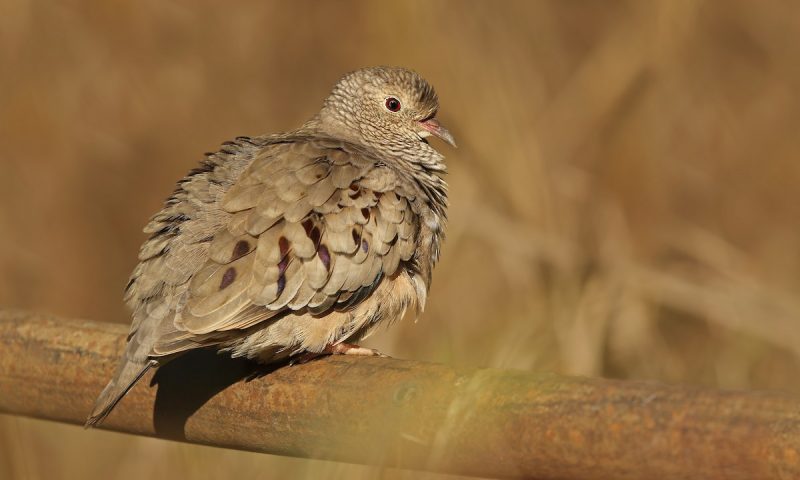
The Common Ground Dove is the smallest dove in North America, about the size of a sparrow. It has a chunky body, short tail, and a scaly appearance on its head and chest. The plumage is generally brown with rusty tones on the wings and a pinkish wash on the underparts.
This species prefers open areas with low vegetation, such as fields, scrublands, and desert edges. It is often seen walking on the ground rather than perching in trees. It feeds primarily on seeds and small insects, often picking through leaf litter or gravel paths.
The Common Ground Dove has a soft, repetitive coo that sounds like “woot-woot-woot.” A fun fact: despite its small size, it is quite resilient and can survive in harsh, dry environments across the southern U.S., Mexico, and parts of Central America.
Inca Dove (Columbina inca)
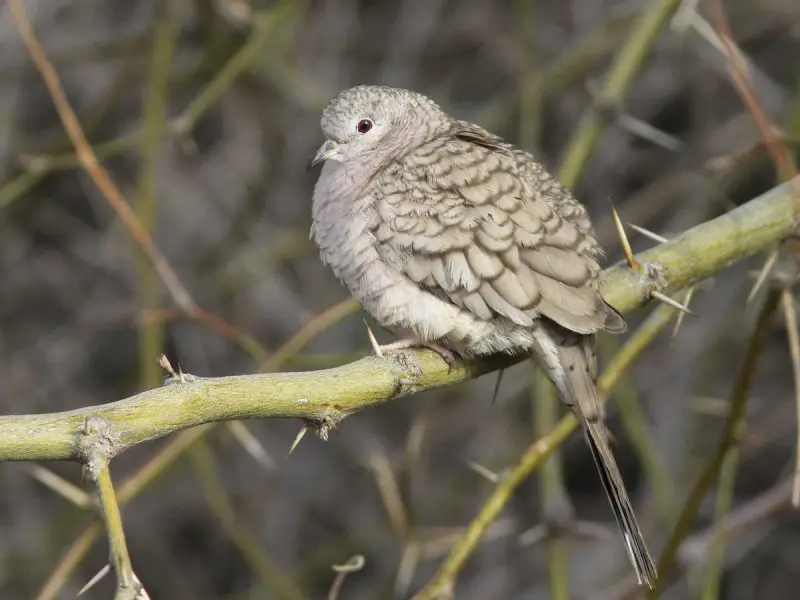
The Inca Dove is a slender, medium-small dove with a distinctive scaled appearance due to the dark edges on its pale gray-brown feathers. Its long, squared tail has white edges that are visible in flight. When flying, its wings produce a light rattling sound.
Native to the southwestern U.S. and Mexico, Inca Doves thrive in urban areas, gardens, and desert towns. They prefer warm climates and are often seen sunbathing on rooftops or ground perches. Their call is a soft, repeated “coo-coo-coo.”
Inca Doves are known for their social behavior and often roost in communal groups during cold weather, forming “dove pyramids” by stacking on top of one another. A fun fact: their feathers provide such excellent insulation that they can tolerate surprisingly low temperatures.
Rock Dove / Rock Pigeon (Columba livia)
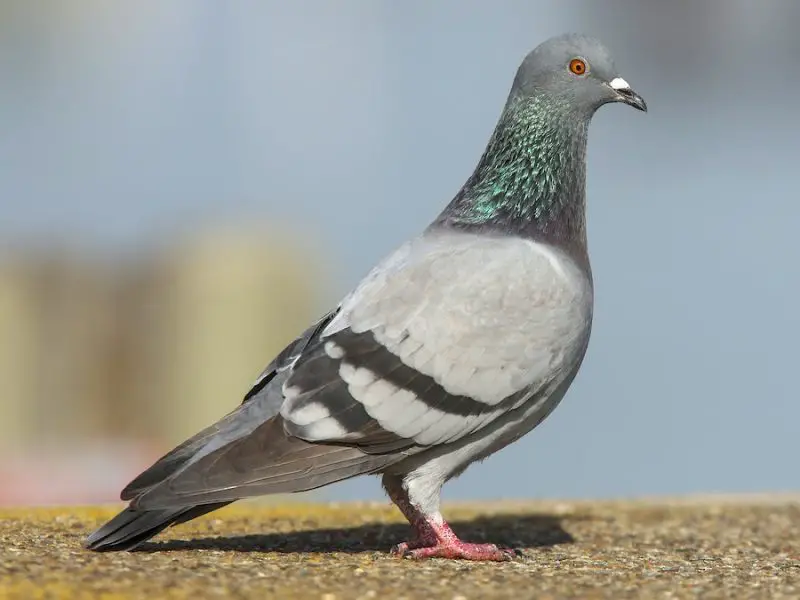
The Rock Dove, also known as the Rock Pigeon, is the ancestor of domestic and feral pigeons found in cities worldwide. It typically has a blue-gray body with iridescent green and purple feathers on the neck and two black wingbars. However, feral individuals can vary widely in color due to selective breeding and hybridization.
Originally native to Europe, North Africa, and parts of Asia, Rock Doves now inhabit urban centers, cliffs, and farmland across all continents except Antarctica. They are highly adaptable and thrive in human-altered environments, often nesting on building ledges and bridges.
Their courtship involves head-bobbing displays and gentle cooing sounds. A fun fact: Rock Doves have been used as messengers for thousands of years due to their strong homing instincts and speed, playing critical roles in communication during wartime.
Spotted Dove (Spilopelia chinensis)

The Spotted Dove is a slender, medium-sized dove easily recognized by the black patch on the nape covered with white spots, giving it a “spotted collar” appearance. Its overall coloration is light brown with pinkish tones on the chest and a long, tapered tail with white edges.
This species is native to South and Southeast Asia but has been introduced to parts of Australia and the Pacific Islands. It prefers open woodlands, gardens, and urban parks, often seen foraging on the ground for seeds and grains.
Spotted Doves produce a distinctive “coo-coo-croo” call that is both soothing and repetitive. A fun fact: they are often considered a symbol of peace and love in their native range and are commonly depicted in traditional Asian art and poetry.
Diamond Dove (Geopelia cuneata)
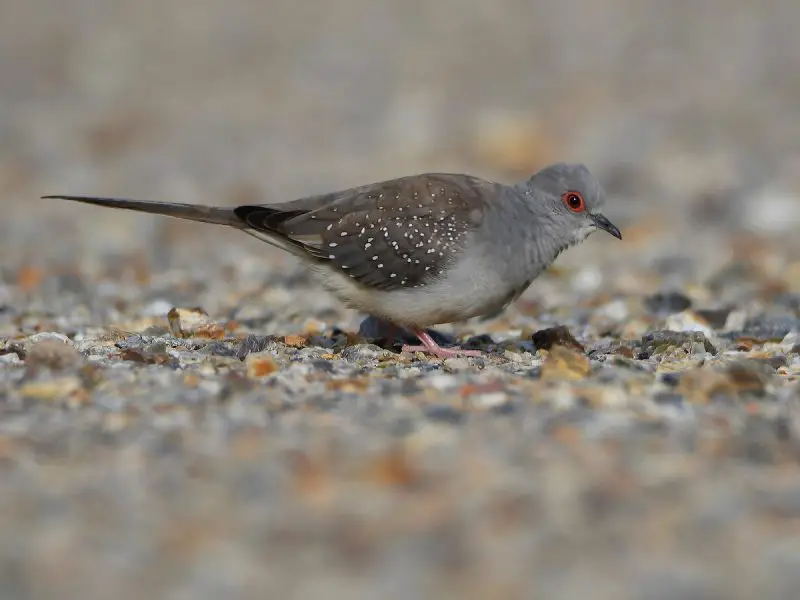
The Diamond Dove is a tiny and delicate species known for its soft gray body and striking white spots (“diamonds”) on its wings. It also features a bright orange or red eye-ring and a long, narrow tail, which gives it an elegant silhouette.
Native to Australia, it inhabits arid and semi-arid open woodlands and grasslands, usually near water sources. It prefers to forage on the ground and is highly dependent on available surface water in dry habitats.
Diamond Doves are gentle and quiet birds, emitting soft, melodic coos. A fun fact: despite their fragile appearance, they are hardy survivors of Australia’s harsh interior and have become popular in aviculture due to their calm temperament.
Laughing Dove (Spilopelia senegalensis)

The Laughing Dove is a small, graceful bird with a pinkish-brown body and a unique scaled pattern on the throat and upper breast. It has long wings, a slender tail, and displays bluish-gray on the wings during flight.
It is widely distributed across Africa, the Middle East, and South Asia, favoring open countryside, farmland, and gardens. These doves are often seen in pairs or small groups, foraging for seeds and grains on the ground.
Their name comes from their distinctive, bubbling call that sounds like gentle laughter. A fun fact: Laughing Doves can adapt to urban life and are frequently seen near homes and streets, where they coexist peacefully with people.
Zebra Dove (Geopelia striata)

The Zebra Dove is a small dove with fine black-and-white barring across the neck, chest, and underparts, giving it a “zebra-striped” look. Its overall color is a blend of brownish-gray with a blue-gray face and a long, narrow tail.
Native to Southeast Asia, especially Indonesia, Thailand, and the Philippines, it has been introduced to Hawaii and other Pacific islands. It prefers open areas like gardens, parks, and farmlands where it can forage on the ground for seeds.
Zebra Doves are known for their soft, rhythmic cooing that resembles a series of gentle whistles. A fun fact: in many parts of Southeast Asia, these doves are kept as pets for their calming songs, and bird singing competitions are held featuring their melodic calls.
White-tipped Dove (Leptotila verreauxi)

The White-tipped Dove is a medium-sized, ground-dwelling dove with a plump body and soft grayish-brown plumage. It gets its name from the distinct white tips on the edges of its tail feathers, which are especially noticeable in flight. Its eyes are ringed with blue skin, giving it a gentle and expressive appearance.
Found from southern Texas through Central America and into parts of South America, this dove prefers dense woodlands, forest edges, and thickets. It forages primarily on the ground for seeds, berries, and insects, and tends to be shy and secretive in behavior.
Its call is a deep, resonant coo that carries through the forest, often heard more than the bird is seen. A fun fact: despite their preference for solitude, White-tipped Doves are remarkably adaptable and are sometimes seen in urban gardens and rural backyards.
Key West Quail-Dove (Geotrygon chrysia)

The Key West Quail-Dove is a rare and strikingly beautiful species with a rich chestnut body, iridescent green wings, and a bold white stripe above the eye. Its body shape is compact, with a short tail and a thick neck, resembling a quail more than a typical dove.
This elusive bird is native to the Caribbean and occasionally seen in southern Florida, especially in the Florida Keys. It prefers tropical hardwood hammocks and dense understory where it quietly walks on the forest floor, feeding on seeds, fruits, and small invertebrates.
Key West Quail-Doves are notoriously hard to spot due to their shy nature and preference for thick vegetation. A fun fact: although named after Key West, sightings there are rare, making each observation an exciting event for birders and ornithologists.
Ruddy Ground Dove (Columbina talpacoti)
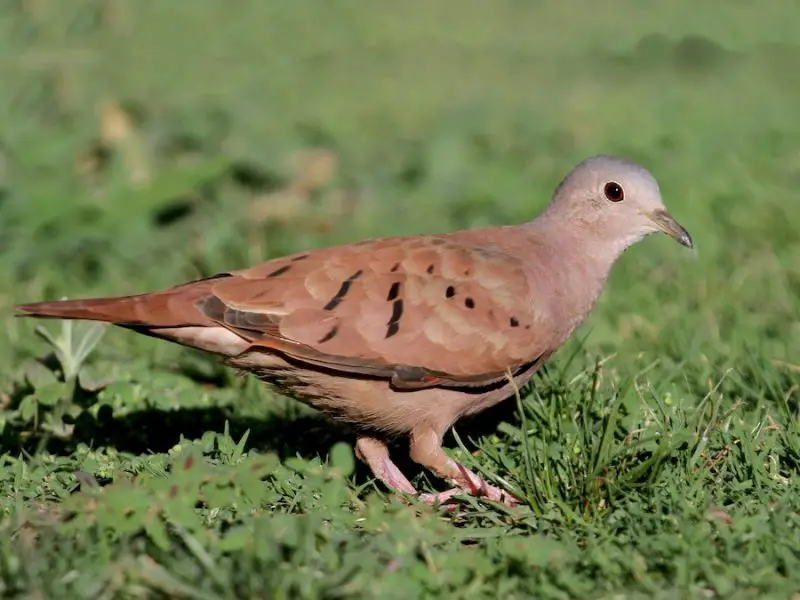
The Ruddy Ground Dove is a small dove with warm reddish-brown (ruddy) coloration, a short tail, and a slender bill. Males are more vibrantly colored, while females tend to be duller with grayish-brown tones. Both sexes display black spots on the wing coverts.
Native to Central and South America, this dove has expanded its range into southern Texas and parts of the southwestern United States. It thrives in open fields, farmland, and scrubby areas, often seen walking in pairs or small flocks on the ground.
Their call is a simple, low-pitched “coo” repeated rhythmically. A fun fact: Ruddy Ground Doves are known to be highly territorial and aggressive during the breeding season, often chasing away much larger birds from their feeding and nesting areas.
Pacific Emerald Dove (Chalcophaps longirostris)
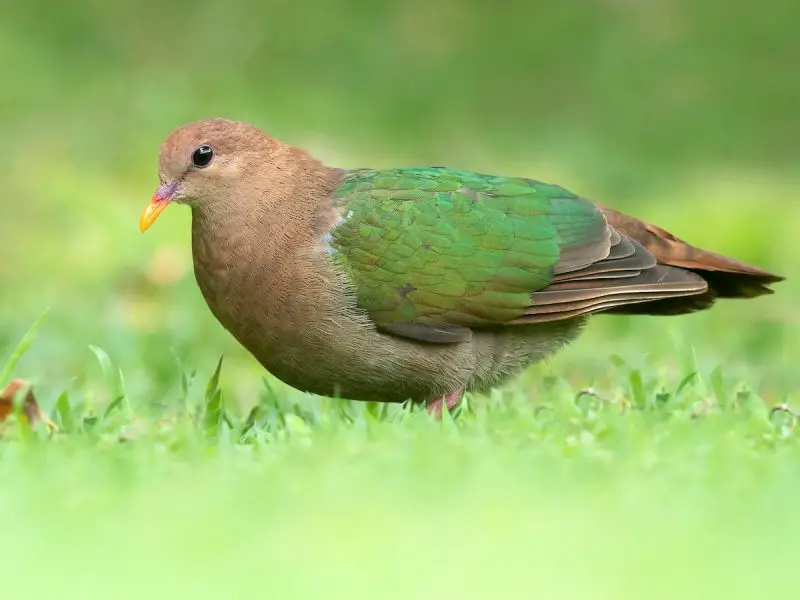
The Pacific Emerald Dove is a dazzling species known for its bright emerald-green wings, rich chestnut body, and pale gray crown. Its white shoulder stripe and striking iridescence make it one of the most eye-catching doves in the region.
Found in tropical and subtropical forests across northern and eastern Australia, Southeast Asia, and parts of the Pacific, this bird favors dense cover and often walks quietly on the forest floor in search of fallen fruits and seeds.
Despite their vivid coloration, they are remarkably hard to spot due to their secretive habits and preference for low, shaded areas. A fun fact: when startled, Emerald Doves take off with a sudden burst of whirring wings and can fly surprisingly fast through dense forest.
Nicobar Pigeon (Caloenas nicobarica)
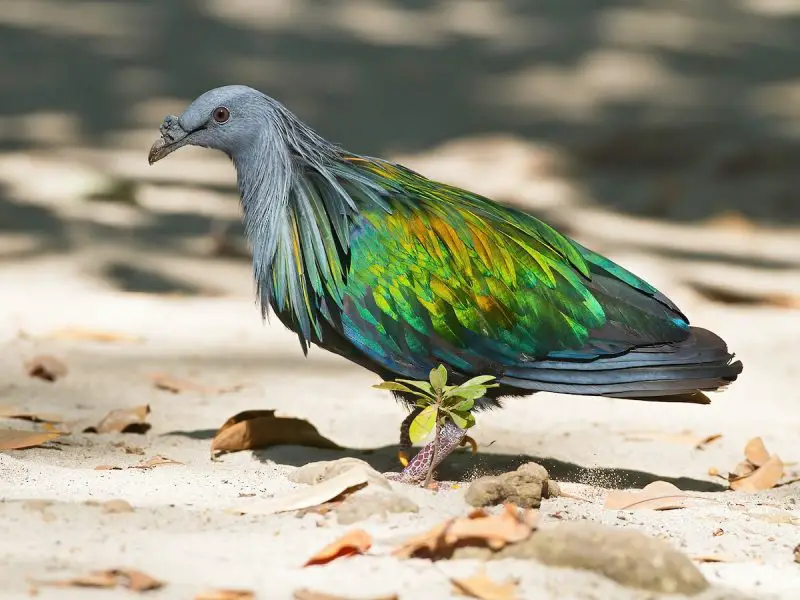
The Nicobar Pigeon is a large, exotic pigeon renowned for its iridescent plumage, which shimmers with shades of green, blue, and bronze. It has long neck hackles and a contrasting white tail, giving it an appearance unlike any other pigeon.
Native to small islands and coastal regions of Southeast Asia and the Pacific, including the Nicobar Islands, this pigeon prefers tropical forests, mangroves, and offshore islets. It feeds on seeds, berries, and plant matter, usually foraging on the ground.
The Nicobar Pigeon is the closest living relative of the extinct Dodo. A fun fact: due to its beauty, it is often targeted in the illegal pet trade, and conservation efforts are in place to protect its declining populations from habitat loss and hunting.
Pink-necked Green Pigeon (Treron vernans)

The Pink-necked Green Pigeon is one of Southeast Asia’s most colorful pigeons. Males are especially vibrant, displaying a pinkish-purple neck, orange breast, green wings, and a bluish-gray head. Females are less showy, primarily olive-green, but still attractive with subtle coloration.
This species is commonly found in mangroves, secondary forests, parks, and even urban gardens throughout Southeast Asia, including Thailand, Malaysia, Singapore, and Indonesia. They are fruit-eating pigeons and play an important role in seed dispersal in tropical ecosystems.
Despite their bright colors, they can be hard to spot due to their preference for staying high in the canopy. A fun fact: these pigeons often gather in flocks near fruiting trees, and their flight is fast and direct, with sharp wingbeats that help them maneuver through dense foliage.
African Collared-Dove (Streptopelia roseogrisea)
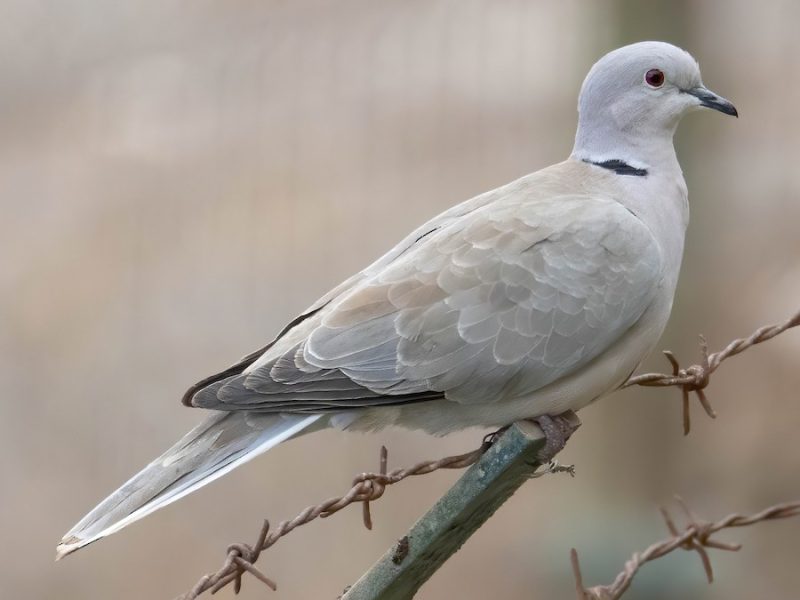
The African Collared-Dove is a pale dove with soft grayish-pink plumage and a distinct narrow black collar on the back of the neck. It resembles the Eurasian Collared-Dove but is slightly smaller and more slender, with a calmer demeanor.
Native to the Sahel region of Africa, it inhabits dry savannas, open woodlands, and semi-arid landscapes. This dove is also commonly domesticated and may interbreed with feral Eurasian Collared-Doves in overlapping regions.
Their call is a rhythmic, soft three-note “coo-COO-coo.” A fun fact: this species is thought to be the wild ancestor of the domesticated Barbary Dove (also known as the Ringed Turtle-Dove), which has been kept by humans for centuries.
Namaqua Dove (Oena capensis)

The Namaqua Dove is a unique and dainty dove with long central tail feathers and a distinctive appearance. Males are easily recognized by their black face and throat, chestnut-colored wings, and elongated tail. Females are paler and lack the black facial markings.
Native to sub-Saharan Africa and parts of the Middle East, Namaqua Doves thrive in dry scrublands, deserts, and open savannas. They are often seen alone or in pairs, walking gracefully along the ground in search of seeds and small insects.
Their flight is swift and erratic, and their call is a high-pitched, nasal “coo.” A fun fact: unlike most doves, the Namaqua Dove’s long tail and striking coloration make it resemble a miniature bird-of-paradise when in motion, especially during courtship displays.
Victoria Crowned Pigeon (Goura victoria)
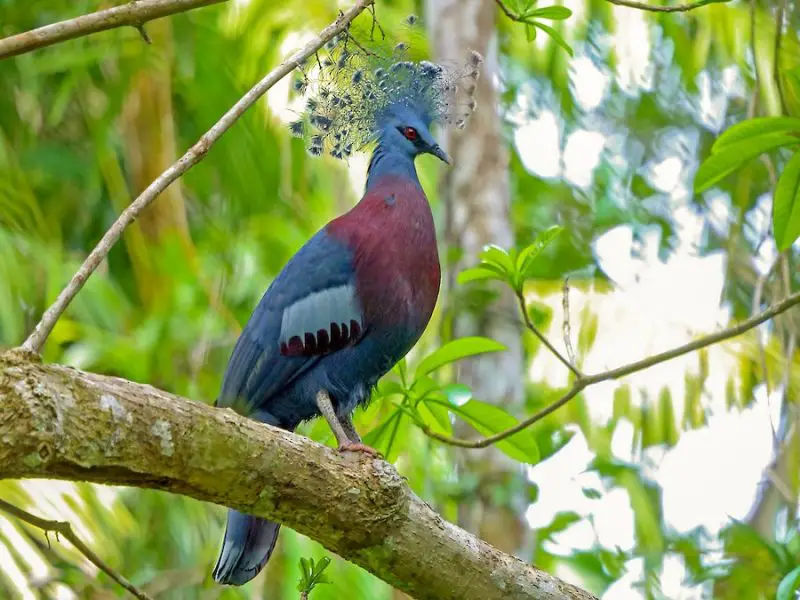
The Victoria Crowned Pigeon is a spectacular and large pigeon, known for its striking blue-gray plumage, deep maroon chest, and elaborate lacy crest of feathers resembling a crown. It is one of the largest pigeon species in the world.
Endemic to the lowland rainforests of northern New Guinea, it prefers dense, humid forest floors and moves slowly as it forages for fallen fruits, seeds, and insects. Despite its large size, it is surprisingly quiet and calm in demeanor.
These pigeons are named in honor of Queen Victoria and are often featured in zoos and aviaries due to their beauty. A fun fact: Victoria Crowned Pigeons display courtship by bowing and emitting deep, booming calls while showing off their elaborate head crests.
White Dove
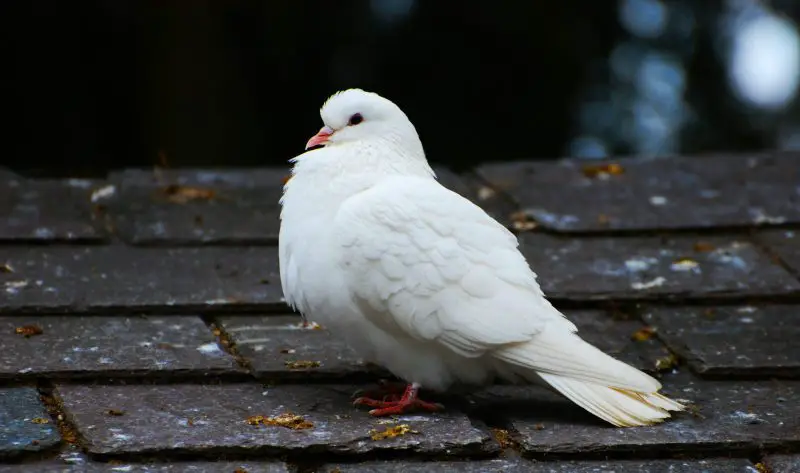
The White Dove is not a wild species but typically refers to domesticated forms of either the Rock Dove (Columba livia) or the Barbary Dove (Streptopelia risoria). These birds are bred to have pure white plumage and are often used in ceremonies or symbolic releases.
White Doves are gentle and accustomed to human interaction, often raised in captivity for ornamental purposes or symbolic events like weddings and peace celebrations. Their exact characteristics vary depending on whether they are derived from pigeons or collared-dove stock.
A fun fact: while symbolic releases are popular, true domesticated White Doves often lack the survival skills of wild birds and may not survive in the wild. Ethical dove releases involve trained homing pigeons that can safely return home after an event.
Lesser-Known and Exotic Dove Species
Blue Ground Dove (Claravis pretiosa)
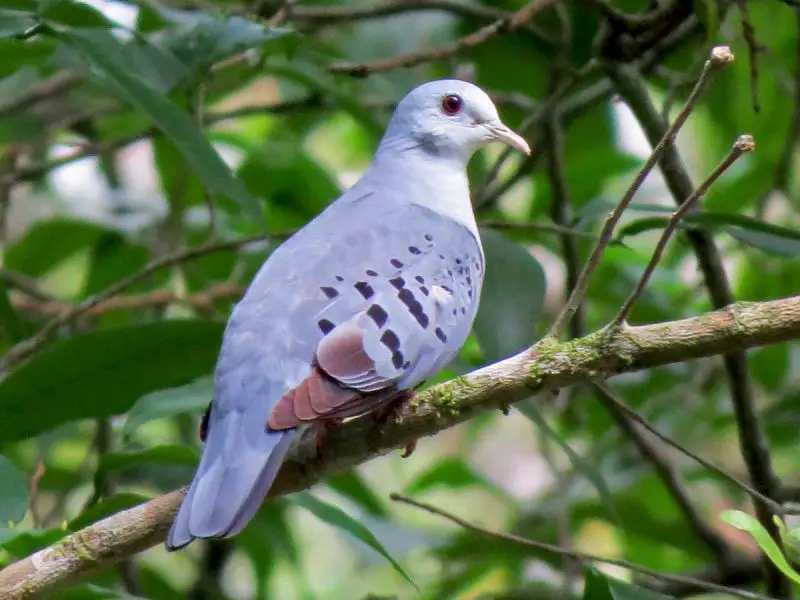
The Blue Ground Dove is a small and visually striking dove, with males exhibiting a bluish-gray body and chestnut wing spots, while females are mostly brown with subtle bluish tones. Their compact build and short tails make them easily recognizable among ground-dwelling doves.
They are found in a wide range across Central and South America, especially in open forests, woodland edges, and grassy clearings. These doves tend to forage alone or in pairs, searching the ground for seeds and small insects.
Despite their name and color, they are often overlooked due to their quiet nature and preference for shaded ground cover. A fun fact: the Blue Ground Dove’s soft cooing is often heard during early morning and late afternoon, signaling territorial presence or courtship.
Plain-breasted Ground Dove (Columbina minuta)
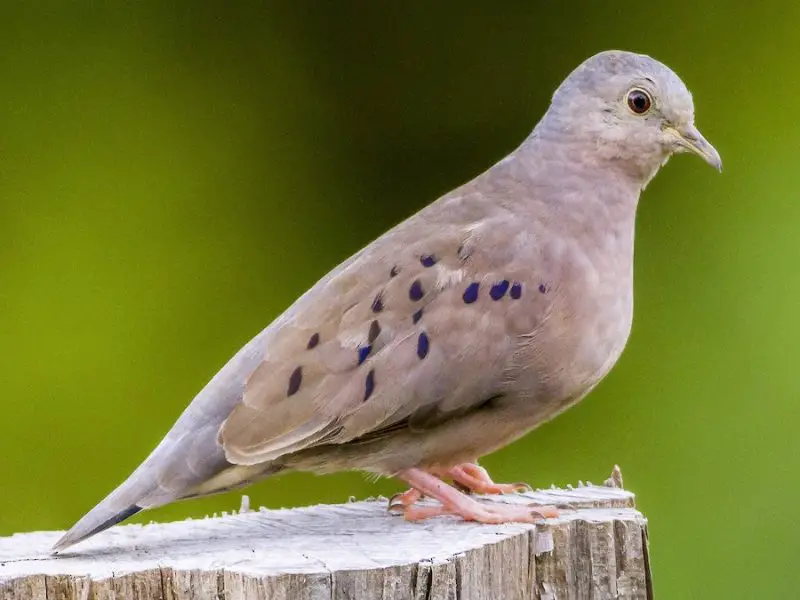
The Plain-breasted Ground Dove is one of the smallest doves in the Americas, measuring only about 5 to 6 inches in length. True to its name, it has a plain, unmarked breast and a compact body with soft brown or grayish plumage.
Its natural range includes southern Texas, Central America, and large parts of northern South America. This tiny dove favors grassy fields, savannas, and scrublands where it can easily blend in while foraging quietly on the ground.
Their soft, insect-like trills are often the only indication of their presence. A fun fact: despite their small size and unassuming appearance, these doves are surprisingly hardy and can tolerate hot, open environments with minimal water.
Scaled Dove (Columbina squammata)
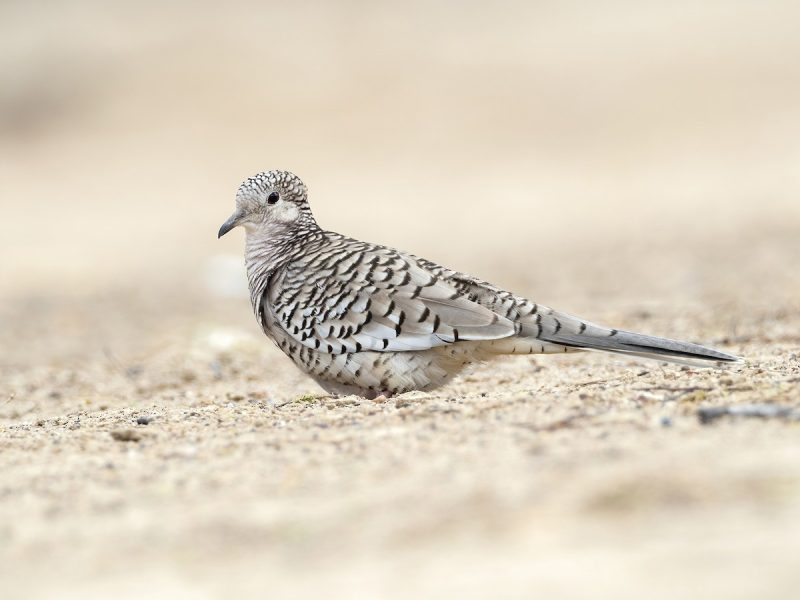
The Scaled Dove is named for its unique plumage that resembles overlapping fish scales, with each feather outlined in dark edges. Its overall coloration ranges from light brown to grayish, with both sexes sharing the distinctive scale pattern.
Native to eastern and central South America, including Brazil, Bolivia, and Argentina, this species lives in dry woodlands, savannas, and even urban parks. It typically feeds on the ground in open areas, consuming seeds and grit for digestion.
Scaled Doves are usually seen alone or in pairs and are known for their soft, repetitive cooing. A fun fact: this species has adapted well to urban environments and can be seen in some cities walking alongside sidewalks and roads.
White-faced Dove (Ptilinopus albifacies)

The White-faced Dove is a rare and elusive species with a soft gray body, slightly iridescent feathers, and a distinct white face that gives it a ghostly appearance. Its subtle coloration contrasts with the colorful members of the Ptilinopus genus, which are usually green.
Endemic to the forests of the Solomon Islands, this dove prefers undisturbed lowland rainforest habitats where it perches quietly in the canopy or forages for fruit. It is rarely seen on the ground and avoids human-inhabited areas.
Its quiet nature and remote range have made it one of the lesser-known fruit doves. A fun fact: due to its limited habitat and elusive behavior, little is known about its exact population status, and it is considered near threatened by conservation groups.
Blue-eyed Ground Dove (Columbina cyanopis)
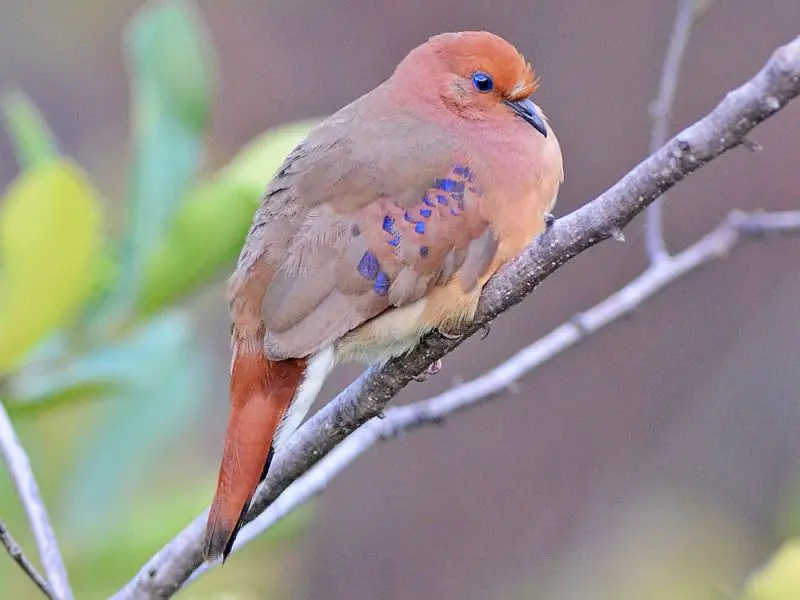
The Blue-eyed Ground Dove is an exceptionally rare and critically endangered species with a pale cinnamon-colored body, deep blue wing spots, and vivid blue eyes—an unusual feature among doves. It has a compact, ground-foraging form like other Columbina species.
Once widespread across southeastern Brazil, it was thought to be extinct until it was rediscovered in 2015. It inhabits the cerrado biome—a type of tropical savanna—where it lives in grasslands with sparse shrubs and trees.
Its rediscovery sparked major conservation efforts, as only a handful of individuals have been observed in the wild. A fun fact: the Blue-eyed Ground Dove’s rarity and striking appearance have made it a symbol of conservation success and hope for Brazil’s disappearing habitats.
Luzon Bleeding-heart Dove (Gallicolumba luzonica)
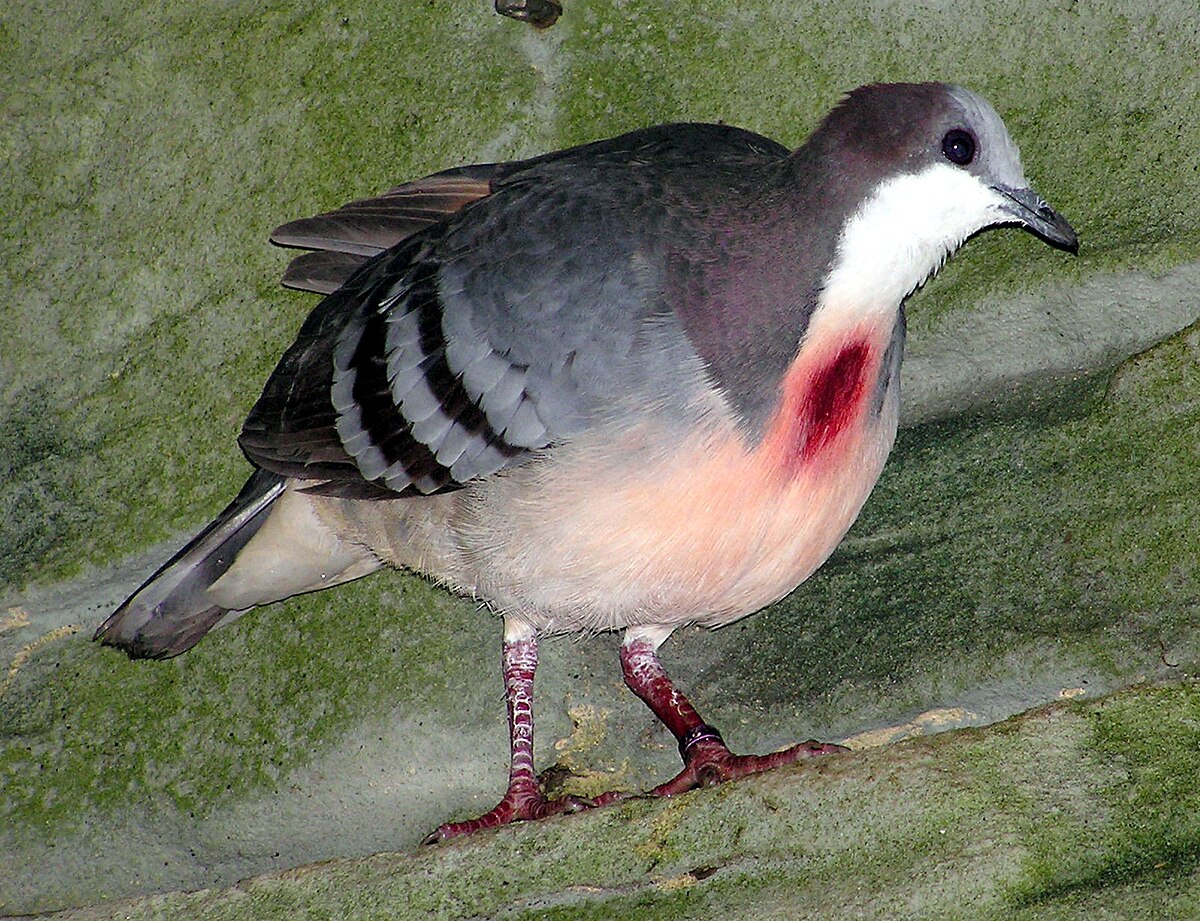
The Luzon Bleeding-heart Dove is a small, ground-dwelling bird known for the vivid, blood-red patch on its white chest that resembles a bleeding wound. Its overall plumage is a blend of soft gray and iridescent green with a pinkish hue on the crown and breast.
This species is endemic to the island of Luzon in the Philippines, where it inhabits dense lowland forests. It forages on the forest floor for seeds, berries, and insects, often moving quietly and remaining hidden in the undergrowth.
Despite its striking appearance, the dove is elusive and vulnerable due to habitat loss and hunting. A fun fact: the dramatic red patch is not an injury but a natural marking used in courtship and species recognition, giving the bird its memorable name.
Wonga Pigeon (Leucosarcia melanoleuca)
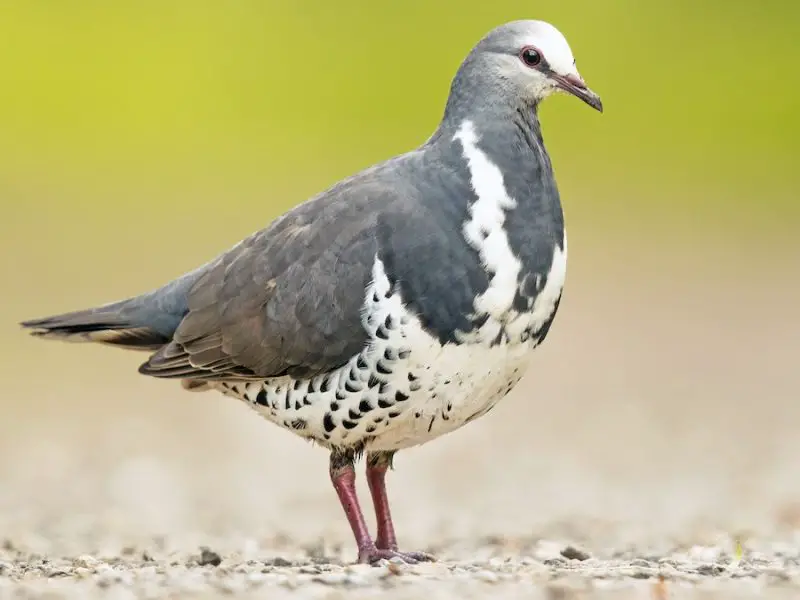
The Wonga Pigeon is a large, stocky ground pigeon with a smooth gray back, white underparts spotted with dark chevrons, and a distinct white line across the face and neck. It has a calm demeanor and a deep, resonant call often heard in Australian forests.
Native to eastern Australia, it is commonly found in rainforests, wet sclerophyll forests, and occasionally in suburban gardens near bushland. It forages on the ground, feeding on seeds, fallen fruit, and occasionally small invertebrates.
Wonga Pigeons are solitary or seen in pairs, rarely forming large flocks. A fun fact: when alarmed, they can take off with a loud clatter of wings, surprising predators and birdwatchers alike.
Superb Fruit Dove (Ptilinopus superbus)
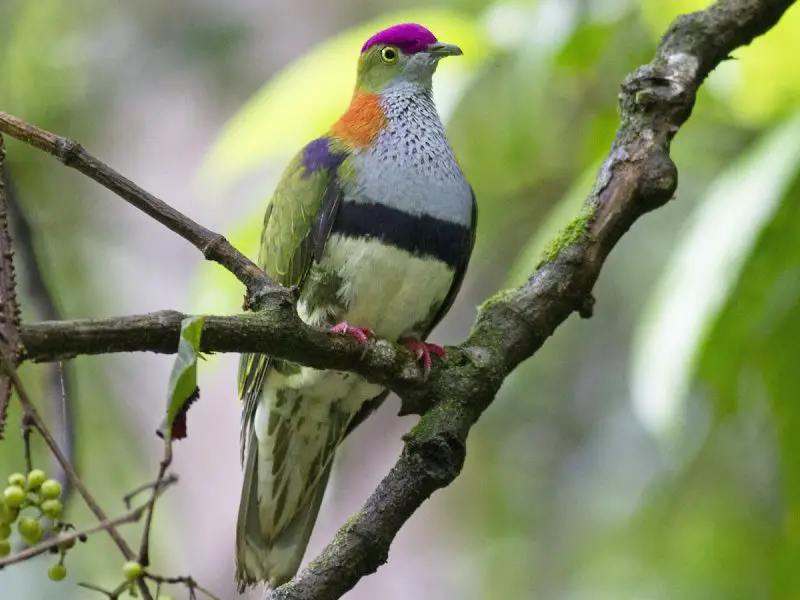
The Superb Fruit Dove lives up to its name with brilliant, multi-colored plumage. Males display a purple crown, green wings, orange breast patch, and blue underparts, while females are mostly green with subtle coloration, aiding in camouflage among foliage.
It is found in rainforests of Southeast Asia, New Guinea, and northeastern Australia. This arboreal dove feeds on fruit in the canopy and is essential for seed dispersal in tropical ecosystems.
Though small and often hidden among leaves, their presence is betrayed by soft, low-pitched coos. A fun fact: the Superb Fruit Dove is a strong flier and may travel long distances between fruiting trees, making it a vital part of rainforest ecology.
Black-naped Fruit Dove (Ptilinopus melanospilus)

The Black-naped Fruit Dove is a vibrantly colored pigeon, with males having a white head, yellow belly, green wings, and a distinctive black patch on the nape. Females are entirely green with lighter underparts, blending well into forest foliage.
It ranges across parts of Southeast Asia including the Philippines and Indonesia, where it inhabits tropical forests and forest edges. This fruit-eating dove prefers high perches and seldom comes to the ground.
Its quiet, soft coos can be difficult to locate, and it is often seen only as a flash of green in the treetops. A fun fact: despite their dazzling colors, these birds rely on stillness and leafy cover to avoid predators.
Rose-crowned Fruit Dove (Ptilinopus regina)
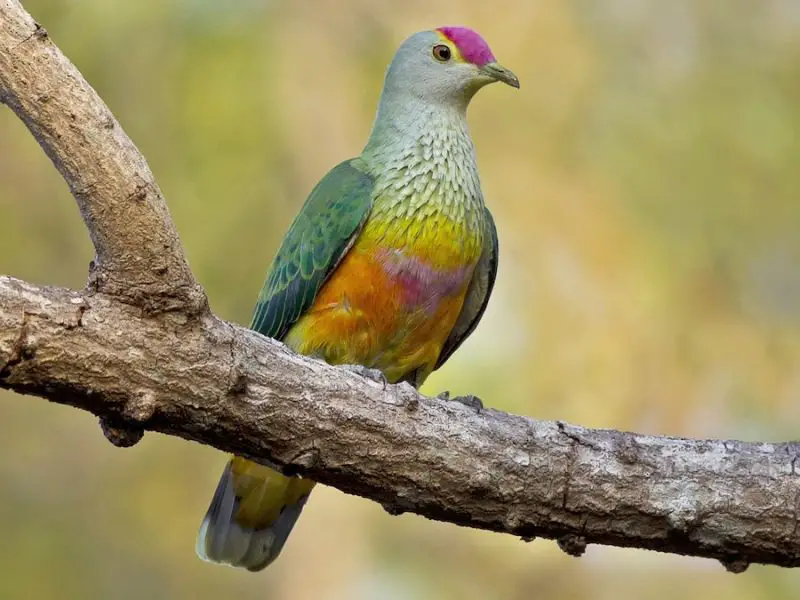
The Rose-crowned Fruit Dove is a small, vividly colored bird with green plumage, a gray chest, and a stunning pinkish-red crown bordered by yellow. Males and females look similar, though the crown is brighter in males.
It is native to rainforests and coastal woodlands in northern and eastern Australia, as well as parts of Indonesia and Papua New Guinea. This dove feeds almost exclusively on soft fruits and berries in the canopy layer.
It’s shy and often overlooked despite its beauty, but its soft “coo-coo” calls give away its presence. A fun fact: the Rose-crowned Fruit Dove plays a crucial role in rainforest regeneration by dispersing the seeds of native fruit-bearing trees.
Orange Dove (Ptilinopus victor)
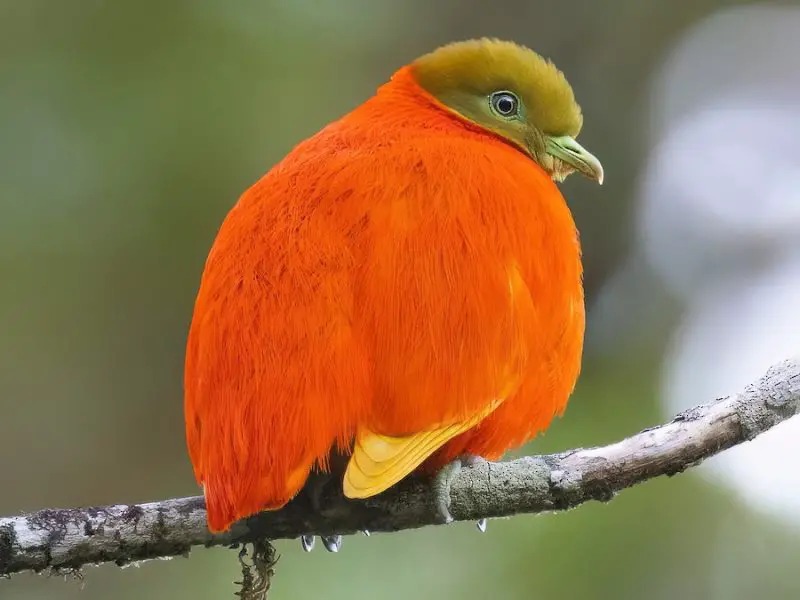
The Orange Dove is a dazzling species found only in the forests of Fiji’s larger islands. The male is particularly eye-catching with vivid orange plumage and a contrasting green head, while the female is entirely green for better camouflage in the canopy. Their small size and bright color make them a visual delight in their natural habitat.
These birds live in tropical rainforests and feed primarily on fruit, playing a crucial role in seed dispersal. They prefer dense, undisturbed forests and are usually seen alone or in pairs, high up in the treetops where they quietly forage.
Despite their bright color, they can be surprisingly difficult to spot due to their quiet nature and preference for high canopies. A fun fact: the Orange Dove is sometimes referred to as the “flame dove” because of the male’s fiery orange appearance amidst green foliage.
White-crowned Pigeon (Patagioenas leucocephala)
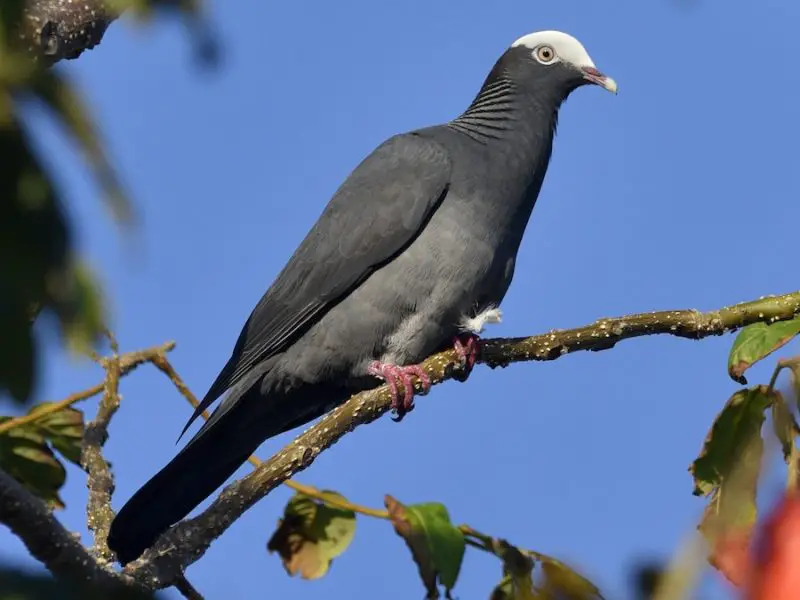
The White-crowned Pigeon is a large, sleek bird with dark, slate-gray body plumage and a distinctive white crown atop its head. Its red eyes and legs add to its striking appearance, and its powerful flight makes it well-suited for long-distance travel.
This pigeon is native to the Caribbean and parts of southern Florida, where it inhabits coastal mangroves, hardwood hammocks, and island forests. It feeds on fruits and berries, often flying between islands in search of food and nesting sites.
The White-crowned Pigeon is a shy and wary bird, easily flushed by human presence. A fun fact: it is one of the few pigeon species in the U.S. that depends on tropical hardwood forests, making it vulnerable to habitat loss from coastal development.
Thick-billed Ground Dove (Gallicolumba salamonis)
The Thick-billed Ground Dove was a unique and rare species endemic to the Solomon Islands, named for its robust beak and terrestrial habits. It had a reddish-brown body with a paler underside and a short tail, adapted for life close to the ground.
Very little is known about its behavior or ecology due to its extremely limited range and early extinction. It was likely a shy forest dweller, foraging among leaf litter for seeds and fallen fruit. Deforestation and introduced predators such as cats and rats likely played a role in its disappearance.
Considered critically endangered and possibly extinct, no confirmed sightings have occurred since the early 20th century. A fun fact: it is one of the most mysterious Pacific island doves, with only a few museum specimens in existence today.
Grey-fronted Dove (Leptotila rufaxilla)

The Grey-fronted Dove is a medium-sized bird with a rosy breast, grayish head, and brown back. Its pale gray forehead distinguishes it from similar species, and it also has a subtle iridescence on the neck when seen in the right light.
It is widespread in tropical forests of South America, particularly in the Amazon Basin. The dove typically stays close to the ground, walking slowly through the leaf litter in search of seeds, berries, and insects. It prefers humid, shaded environments and avoids open areas.
Known for its low, mournful cooing, the Grey-fronted Dove is more often heard than seen. A fun fact: despite its inconspicuous appearance, it is an important seed disperser in South American rainforest ecosystems.
Grenada Dove (Leptotila wellsi)
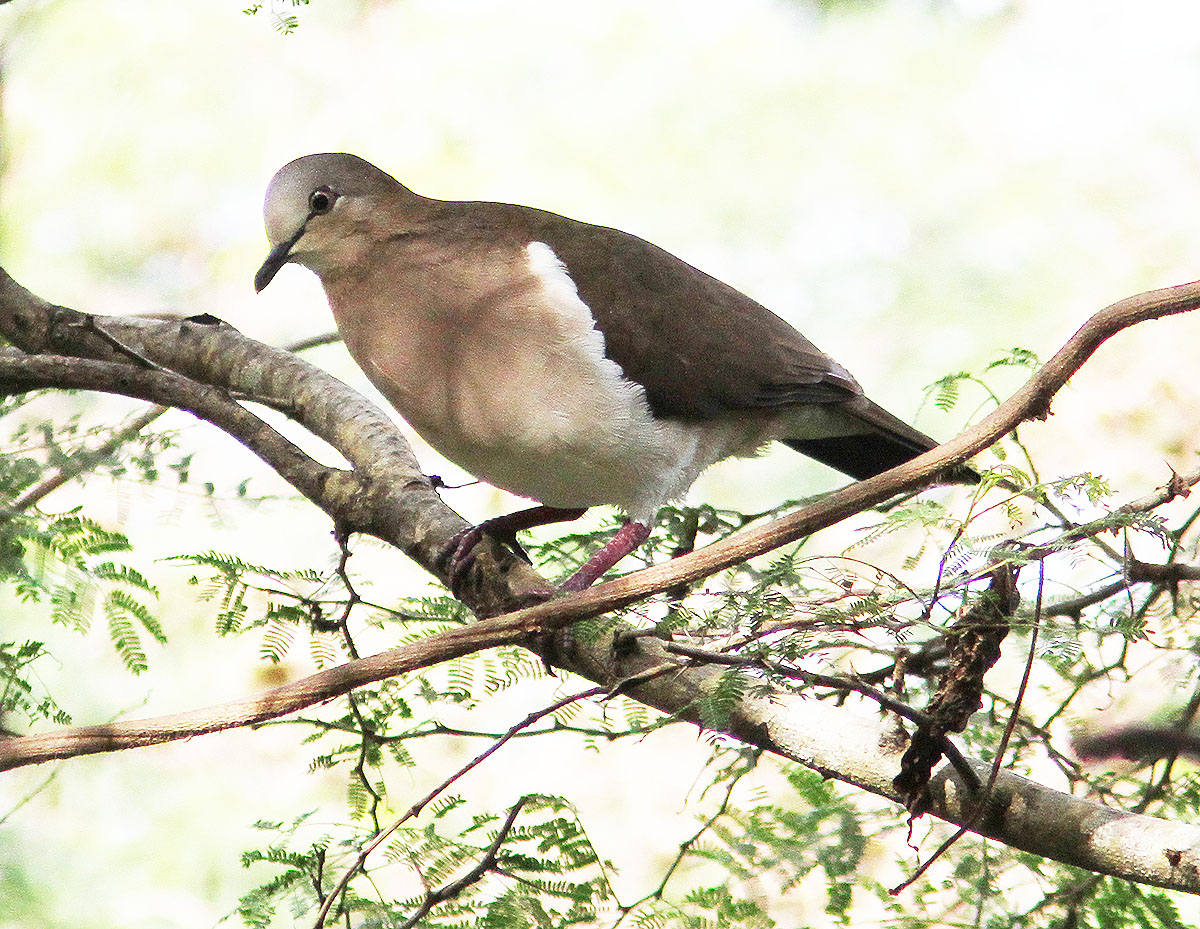
The Grenada Dove is a critically endangered species found only on the Caribbean island of Grenada. It has warm brown plumage, a pale pinkish chest, and a distinctive white line behind the eye. Its appearance is subtle but elegant.
Restricted to dry coastal forests and scrub habitats, it is highly dependent on undisturbed land with thick undergrowth. Habitat loss from agriculture, development, and tourism has severely impacted its population, which is estimated at fewer than 200 individuals.
Efforts to conserve the Grenada Dove include habitat protection and public awareness campaigns. A fun fact: it is Grenada’s national bird and a symbol of conservation hope, though it remains one of the rarest doves in the Western Hemisphere.
Bare-eyed Ground Dove (Metriopelia ceciliae)
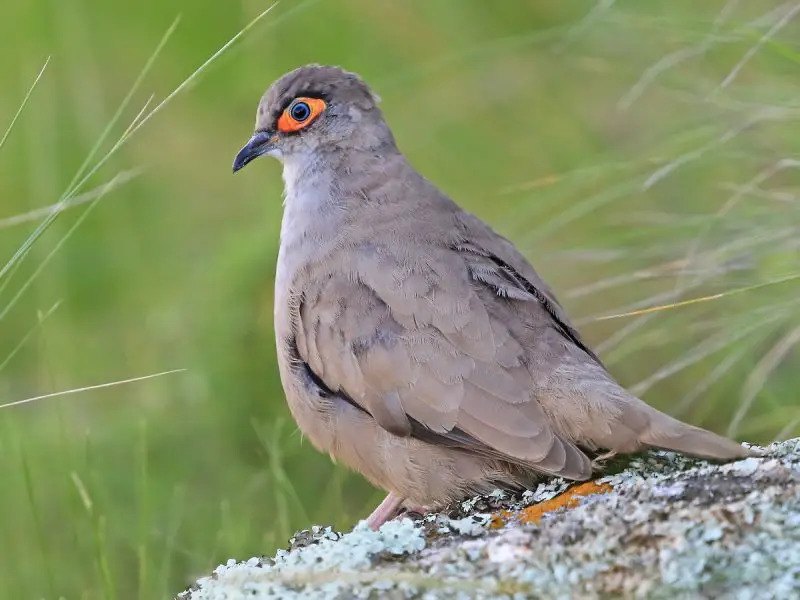
The Bare-eyed Ground Dove is a unique species native to the high-altitude regions of the Andes in South America, especially in countries like Peru, Bolivia, and Argentina. It is easily recognized by the bare blue skin around its eyes, which contrasts with its grayish-brown body and slightly iridescent feathers.
This dove inhabits arid montane shrublands and rocky areas, often at elevations between 2,500 and 4,500 meters. It forages mainly on the ground, feeding on seeds and small plant matter, and is well-adapted to the cold, dry conditions of its environment.
Despite its harsh habitat, the Bare-eyed Ground Dove maintains a calm and quiet demeanor. A fun fact: unlike many other doves, this species has adapted to live year-round in high-altitude conditions, where oxygen levels are low and temperatures can drop dramatically.
Dusky Turtle Dove (Streptopelia lugens)
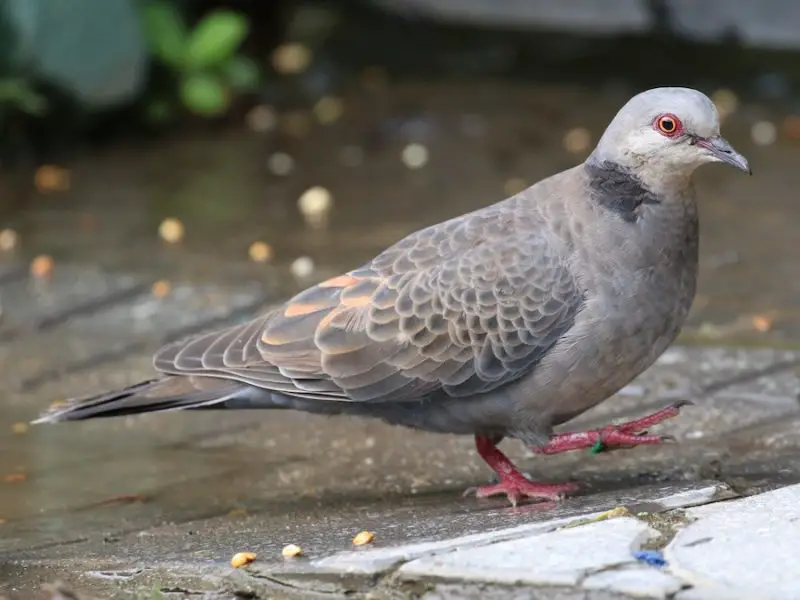
The Dusky Turtle Dove is a medium-sized dove with a soft brownish-gray plumage and a characteristic black-and-white patch on the side of its neck. It is slightly darker in coloration compared to other turtle doves, giving it a “dusky” appearance.
This species is found in the highland regions of eastern Africa, including Ethiopia, Kenya, and Tanzania. It prefers forest edges, open woodlands, and gardens at higher elevations, and is commonly seen walking along paths or feeding in grassy clearings.
Known for its gentle cooing, the Dusky Turtle Dove is often heard before it is seen. A fun fact: although its range overlaps with other dove species, it can be distinguished by its darker body and higher-altitude preference.
Philippine Cuckoo-Dove (Macropygia tenuirostris)

The Philippine Cuckoo-Dove is a slender, long-tailed dove with a reddish-brown plumage and delicate black spotting on its breast. It has a graceful, slightly curved profile, and its quiet nature makes it a peaceful presence in the forest.
Endemic to the Philippines, this species inhabits tropical and subtropical lowland forests, especially in mountainous or hilly areas. It is typically solitary or found in pairs, foraging on the forest floor for seeds, berries, and small fruits.
This dove’s soft, low-pitched calls are more commonly heard than the bird is seen. A fun fact: the Philippine Cuckoo-Dove’s cryptic coloration helps it blend seamlessly with the forest understory, making it a challenge to spot in the wild.
Bar-shouldered Dove (Geopelia humeralis)

The Bar-shouldered Dove is an attractive species easily recognized by the scaled pattern on its nape and shoulders, featuring coppery-brown “bars” that give it its name. Its body is mostly gray with a pale underside and bluish facial skin.
Native to Australia and southern New Guinea, this dove is commonly found in coastal forests, woodlands, mangroves, and urban parks. It prefers open areas with nearby cover and is often seen walking on the ground in search of seeds.
It produces a distinctive, musical “cook-a-wook” call that’s often heard in the early morning. A fun fact: the Bar-shouldered Dove has adapted well to human-altered environments and is a frequent visitor to suburban gardens and green spaces in Australia.
Peaceful Dove (Geopelia placida)
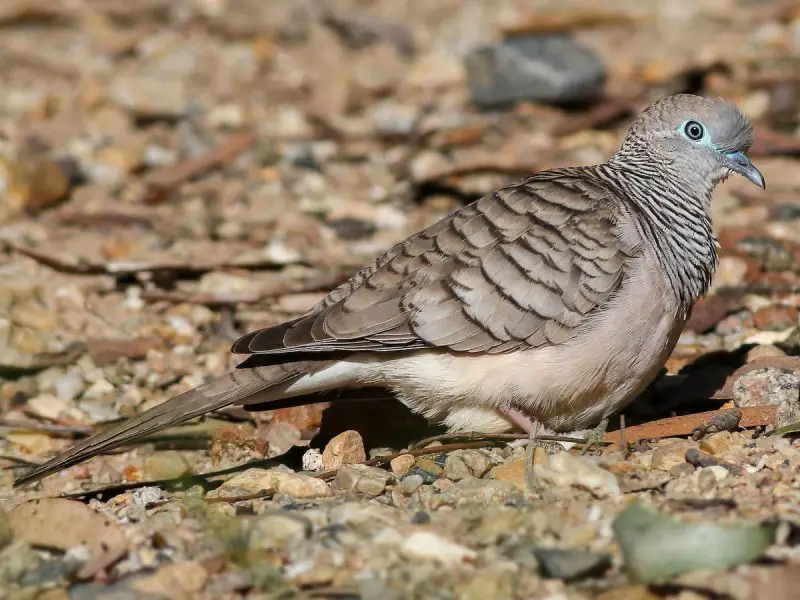
The Peaceful Dove is a small and delicate bird with soft gray plumage and finely barred patterns on the neck and upper body. It has bright blue skin around the eyes, giving it a gentle and endearing expression.
Found widely across northern and eastern Australia and parts of Papua New Guinea, it thrives in open woodlands, scrublands, and gardens. It prefers areas with scattered trees and plenty of ground space for foraging.
True to its name, the Peaceful Dove is quiet and calm, often seen in small groups or pairs pecking for seeds. A fun fact: when taking flight, its wings produce a distinctive whistling sound, a feature it shares with many Geopelia species.







We have a either a mother or father and a young bird in our yard area that we think are rare ! They are pure white with black on both sides of the face, and pure black wings and pure white tail. They resemble doves. If anybody knows any bird watchers or organizations please get in touch with them . THANK YOU